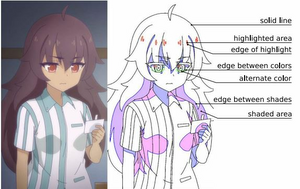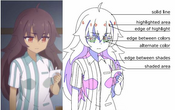Information
- Publication Type: Master Thesis
- Workgroup(s)/Project(s):
- Date: September 2023
- Date (Start): February 2020
- Date (End): 9. March 2023
- TU Wien Library:
- Second Supervisor: Joao Afonso Cardoso
- Diploma Examination: 9. March 2023
- Open Access: yes
- First Supervisor: Michael Wimmer
- Pages: 86
- Keywords: Limited animation, Line arts, Semantic image segmentation
Abstract
The creation of traditional animation is performed in multiple steps, creating various intermediary products. Image processing and machine learning could be used for the automation of some of these time-consuming steps to help animators and studios. However, machine-learning solutions require large amounts of example data, which are not available for the intermediary products of animation. On the other hand, final animation is more easily available through public datasets, video releases, and streaming services. This work aims to bridge this gap by creating a tool to predict intermediary products of animation from frames of the final video, using machine learning. The predicted production data can then be used for further research. In particular, frames of traditional animation are made out of background and foreground elements, which are produced through different workflows. Foreground elements are created by first creating color-coded lineart. These are then colored and composited with the background. In this work, machine learning is used to undo these steps by separating a final frame into the foreground and background and recreating the lineart from the former.Additional Files and Images
Weblinks
BibTeX
@mastersthesis{Kugler-2021,
title = "Reconstructing Production Data from Drawn Limited Animation",
author = "Felix Kugler",
year = "2023",
abstract = "The creation of traditional animation is performed in
multiple steps, creating various intermediary products.
Image processing and machine learning could be used for the
automation of some of these time-consuming steps to help
animators and studios. However, machine-learning solutions
require large amounts of example data, which are not
available for the intermediary products of animation. On the
other hand, final animation is more easily available through
public datasets, video releases, and streaming services.
This work aims to bridge this gap by creating a tool to
predict intermediary products of animation from frames of
the final video, using machine learning. The predicted
production data can then be used for further research. In
particular, frames of traditional animation are made out of
background and foreground elements, which are produced
through different workflows. Foreground elements are created
by first creating color-coded lineart. These are then
colored and composited with the background. In this work,
machine learning is used to undo these steps by separating a
final frame into the foreground and background and
recreating the lineart from the former.",
month = sep,
pages = "86",
address = "Favoritenstrasse 9-11/E193-02, A-1040 Vienna, Austria",
school = "Research Unit of Computer Graphics, Institute of Visual
Computing and Human-Centered Technology, Faculty of
Informatics, TU Wien",
keywords = "Limited animation, Line arts, Semantic image segmentation",
URL = "https://www.cg.tuwien.ac.at/research/publications/2023/Kugler-2021/",
}

 thesis
thesis

